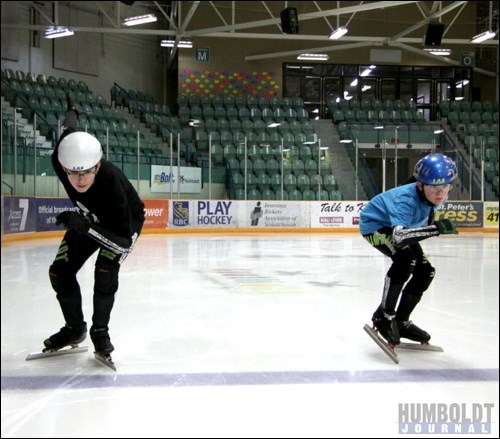Between the smooth stride, the rhythm of the arm swing and the quietness of the arena during practice, one would not think to classify speedskating as an extreme sport. But do not let appearances deceive you.
"It is an extreme sport," said Steve Krueger, coach of the Humboldt Speed Skating Club. "The speeds they reach and the closeness of the competitors makes it an extreme sport."
Essentially, there are two sports - long track and short track -- in which the club competes, explained Krueger. Each utilizes different skate blades and strategy, but both require a solid form and focus on the long-term development of the athlete.
A recent modification has been made at the national level to use benchmarks to develop high performance athletes.
"It is a change in approach that has come down from Speed Skating Canada," said Krueger.
The province of Quebec's successful speed skating program has become the benchmark in which all other provincial programs are compared.
"Quebec athletes were putting in 500 hours of training per year whereas Saskatchewan's total was only 200 training hours per year."
Krueger explained where it was once thought numerous competitions throughout the course of the October to March season was the way to go, now the recommendation is for two to three short track events and three long track ones.
Even with that, injuries are not uncommon within the sport. Each competitor is required to wear a cut-resistant race suit made of kevlar.
"When skaters are racing in such close proximity and at high speeds, accidents and crashes do occur," said Krueger.
In fact Krueger's own son, Jacob inadvertently made a toe stand in a competition last year, that saw him tumble head over heels, resulting in a broken leg. Although that took him off his blades for a short while last year, Jacob is back in his skates for the 2012-2013 season.
"My favourite part of the race is the start," Jacob said. "I also like meeting people from other places in Saskatchewan."
The club has travelled to Saskatoon, Melville, Moose Jaw and Regina for tournaments. Steve Krueger anticipates adding Calgary to the list next season.
They have competed in both indoor and outdoor arenas in temperatures such as -27C.
"To prevent frostbite, you put vaseline on the face," smiled the coach. "We learned that one the hard way."
The lack of a speed skating oval in the city makes it difficult for the local athletes to train as the ends of the hockey rink are not the right depth or shape for making the corners at the speeds at which the racers enter and exit the area.
"It is frustrating," he said.




